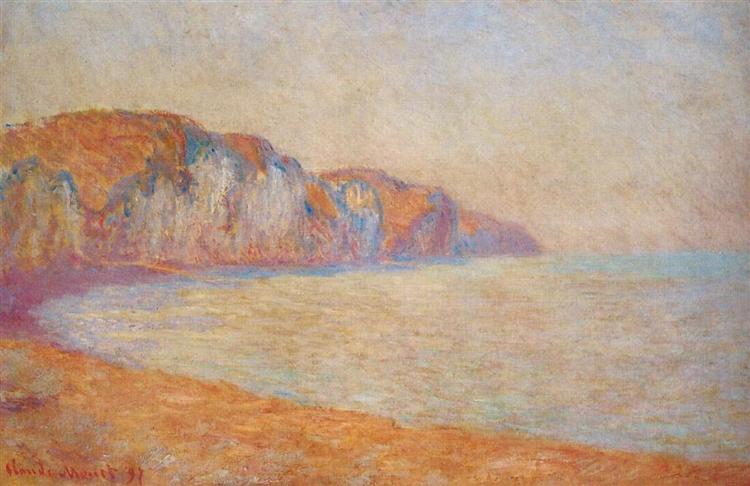Descrizione
Claude Monet's "The Cliff at Pourville in the Morning" (1897) is a splendid example of the French master's Impressionist style. A pioneer of the movement, Monet was dedicated to capturing light and color in their interaction with nature, and this painting is a perfect testament to his mastery. In this painting, Monet transports us to the coast of Normandy, where the cliffs rise dramatically above the sea, creating a scene that resonates with the ephemeral beauty of the seascape.
The composition of "Pourville Cliff in the Morning" is notable for its dynamism and balance. The cliffs, with their irregular profile and earthy tones, dominate the left side of the work. Monet uses a palette rich in shades of blue and green to depict the ocean's mantle, suggesting both the calm of the morning and the depth of the sea. The reflections of sunlight on the water are rendered in the artist's characteristic loose and rapid brushstrokes, which lend movement and vitality to the scene. The choice of location, which captures the Pourville coastline where Monet stayed on several occasions, is fundamental to understanding his emotional and aesthetic connection to the place.
The treatment of colour is a central aspect of this work. Monet deploys a mix of hues ranging from the intense blues of the sky and sea to the yellows and whites of the rising sun. The shadows on the cliffs have been modelled with subtle shades of grey and green, displaying his ability to work with colour intuitively. The contrast between light and shadow creates an atmosphere of morning freshness, inviting the viewer to experience the serenity of the moment.
In the lower central part of the painting, a pair of tiny figures can be distinguished venturing along the beach. This inclusion of characters, although secondary, enriches the narrative of the work, suggesting the relationship of the human being with the majesty of nature. The figures, almost spectral in their representation, become an echo of the vastness of the landscape, reminding us of the insignificance of the human being in the face of the immensity of the natural world.
It is interesting to note that Monet made several studies of this same subject, constantly reflecting on the light and atmosphere of the coast. The various versions and studies he created here demonstrate his dedication to capturing the uniqueness of each moment, affirming the Impressionist philosophy that art is an interpretation of the lived moment. This work, along with others such as "Cliff with Trees" and "Low Tide at Pourville", is part of his visual exploration of the coast and reveals how Monet, through his technique, managed to reveal the essence of the landscape.
"The Cliff at Pourville in the Morning" is not only a visual representation of a landscape, but a meditation on light, color, and the passage of time. Through his rapid brushstroke technique, Monet invites us to perceive the ever-changing life that exists in nature, a fundamental principle of Impressionism. This canvas, like many by its author, continues to challenge and delight viewers, reaffirming the importance of individual perception in the experience of art. In encountering this work, we are reminded of the need to contemplate the world around us, a principle that resonates deeply in Monet's artistic practice and his enduring legacy.
KUADROS ©, a famous painting on your wall.
Hand-made oil painting reproductions, with the quality of professional artists and the distinctive seal of KUADROS ©.
Painting reproduction service with satisfaction guarantee. If you are not completely satisfied with the replica of your painting, we will refund 100% of your money.

